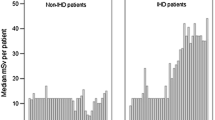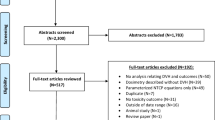Abstract
Myriad radiation effects, including benefits and detriments, complicate justifying and optimizing radiation exposures. The purpose of this study was to develop a comprehensive conceptual framework and corresponding quantitative methods to aggregate the detriments and benefits of radiation exposures to individuals, groups, and populations. In this study, concepts from the ICRP for low dose were integrated with clinical techniques focused on high dose to develop a comprehensive figure of merit (FOM) that takes into account arbitrary host- and exposure-related factors, endpoints, and time points. The study built on existing methods with three new capabilities: application to individuals, groups, and populations; extension to arbitrary numbers and types of endpoints; and inclusion of limitation, where relevant. The FOM was applied to three illustrative exposure situations: emergency response, diagnostic imaging, and cancer radiotherapy, to evaluate its utility in diverse settings. The example application to radiation protection revealed the FOM’s utility in optimizing the benefits and risks to a population while keeping individual exposures below applicable regulatory limits. Examples in diagnostic imaging and cancer radiotherapy demonstrated the FOM’s utility for guiding population- and patient-specific decisions in medical applications. The major finding of this work is that it is possible to quantitatively combine the benefits and detriments of any radiation exposure situation involving an individual or population to perform cost-effectiveness analyses using the ICRP key principles of radiation protection. This FOM fills a chronic gap in the application of radiation-protection theory, i.e., limitations of generalized frameworks to algorithmically justify and optimize radiation exposures. This new framework potentially enhances objective optimization and justification, especially in complex exposure situations.










Similar content being viewed by others
Notes
Exposure limits represent a mechanism to constrain algorithmic optimization from converging on a solution that concentrates risk, e.g., in one person in a group. This allows explicit consideration of the ethical principal of justice in the optimization.
While we chose to calculate cumulative lifetime figures of merit, one could also calculate for arbitrary values of attained age \(a\ge e\) (the age at exposure).
Other, more detailed models may be used to calculate the probability of beneficial and/or detrimental effects, such as those published in the Biological Effects of Ionizing Radiation (BEIR VII) report. For simplicity, we used the model from the International Commission on Radiological Protection (ICRP) Publication 60 in this work.
These were used for simplicity. More accurate data are available and could be used in this framework.
References
Anderson RN, DeTurk PB (2002) United States life tables, 1999. National vital Stat Rep 50(6):1–39
Arias E (2012) United States life tables, 2008. National Vital Stat Rep 61(3):1–64
Arias E, Heron M, Xu J (2017) United States life tables, 2014. National Vital Stat Rep 66(4):1–64
Austin AM, Douglass MJJ, Nguyen GT, Penfold SN (2017) A radiobiological Markov simulation tool for aiding decision making in proton therapy referral. Phys Med 44(Supplement C):72–82. https://doi.org/10.1016/j.ejmp.2017.11.013
BFCR (2000) A guide to justification for clinical radiologists. Royal College of Radiologists, London
BFCR (2015) A guide to understanding the implications of the ionising radiation (medical exposure) regulations in diagnostic and interventional radiology, vol 15. The Royal College of Radiologists, London
Brodin NP, Vogelius IR, Bjork-Eriksson T, Munck Af Rosenschold P, Maraldo MV, Aznar MC, Specht L, Bentzen SM (2014) Optimizing the radiation therapy dose prescription for pediatric medulloblastoma: minimizing the life years lost attributable to failure to control the disease and late complication risk. Acta Oncol 53(4):462–470. https://doi.org/10.3109/0284186X.2013.858824
Chauhan V, Said Z, Daka J, Sadi B, Bijlani D, Marchetti F, Beaton D, Gaw A, Li C, Burtt J, Leblanc J, Desrosiers M, Stuart M, Brossard M, Vuong NQ, Wilkins R, Qutob S, McNamee J, Wang Y, Yauk C (2019) Is there a role for the adverse outcome pathway framework to support radiation protection? Int J Radiat Biol 95(2):225–232. https://doi.org/10.1080/09553002.2019.1532617
Conant EF, Beaber EF, Sprague BL, Herschorn SD, Weaver DL, Onega T, Tosteson ANA, McCarthy AM, Poplack SP, Haas JS, Armstrong K, Schnall MD, Barlow WE (2016) Breast cancer screening using tomosynthesis in combination with digital mammography compared to digital mammography alone: a cohort study within the PROSPR consortium. Breast Cancer Res Treat 156(1):109–116. https://doi.org/10.1007/s10549-016-3695-1
Corbett RH, Faulkner K (1998) Justification in radiation protection. Br J Radiol 71(849):905–907. https://doi.org/10.1259/bjr.71.849.10195001
Daşu A, Toma-Daşu I, Franzén L, Widmark A, Nilsson P (2011) Secondary malignancies from prostate cancer radiation treatment: a risk analysis of the influence of target margins and fractionation patterns. Int J Radiat Oncol Biol Phys 79(3):738–746. https://doi.org/10.1016/j.ijrobp.2009.12.004
Do K-H (2016) General principles of radiation protection in fields of diagnostic medical exposure. J Korean Med Sci 31(1):S6–S9
Donnelly EH, Nemhauser JB, Smith JM, Kazzi ZN, Farfán EB, Chang AS, Naeem SF (2010) Acute radiation syndrome: assessment and management. South Med J 103(6):541–546. https://doi.org/10.1097/smj.0b013e3181ddd571
Faber JF, Wade AH (1983) Life tables for the United States: 1900–2050. U.S. Department of Health and Human Services, USA
Gillon R (1994) Medical ethics: four principles plus attention to scope. BMJ (Clin Res ed) 309(6948):184–188
Hendrick RE (2010) Radiation doses and cancer risks from breast imaging studies. Radiology 257(1):246–253. https://doi.org/10.1148/radiol.10100570
Hoffmann AL, Huizenga H, Kaanders JH (2013) Employing the therapeutic operating characteristic (TOC) graph for individualised dose prescription. Radiat Oncol 8(55):1–9
Holthusen H (1936) Erfahrungen über die Verträglichkeitsgrenze für Röntgenstrahlen und deren Nutzanwendung zur Verhütung von Schäden. Strahlentherapie 57:254–269
IAEA, WHO (2014) Bonn call for action: 10 actions to improve radiation protection in medicine in the next decade. International Atomic Energy Agency/World Health Organization, Vienna
ICRP (1966) Recommendations of the international commission on radiological protection. ICRP Publication 9, Pergamon Press, Oxford
ICRP (1973) Implications of commission recommendations that doses be kept as low as readily achievable. ICRP Publication 22, Pergamon Press, Oxford
ICRP (1977) Recommendations of the ICRP. ICRP publication 26, Ann. ICRP, vol 1. The International Commission on Radiological Protection, New York
ICRP (1990) Optimization and decision making in radiological protection. ICRP publication 55, Annals of the ICRP 20(1)
ICRP (1991) Recommendations of the international commission on radiological protection. ICRP publication 60, Ann. ICRP, vol 21. International Commission on Radiological Protection, Oxford
ICRP (2006) The Optimisation of Radiological Protection—Broadening the Process. ICRP Publication 101b. Ann ICRP 36(3)
ICRP (2007) The 2007 recommendations of the international commission on radiological protection. ICRP publication 103. Ann. ICRP 37(2–4)
ICRP (2012) Compendium of dose coefficients based on ICRP publication 60. ICRP publication 119. Annals of the ICRP 41(Suppl.)
ICRP (2018) Ethical foundations of the system of radiological protection. ICRP publication 138. Ann ICRP 47(1)
Jeong R-D, Jeong M-A, Park M-R (2017) Gamma irradiation-induced disease resistance of pear (Pyrus pyrifolia “Niitaka”) against Penicillium expansum. J Phytopathol 165(9):626–633. https://doi.org/10.1111/jph.12601
Kallman P, Lind BK, Brahme A (1992) An algorithm for maximizing the probability of complication-free tumour control in radiation therapy. Phys Med Biol 37(4):871
Langendijk JA, Lambin P, De Ruysscher D, Widder J, Bos M, Verheij M (2013) Selection of patients for radiotherapy with protons aiming at reduction of side effects: the model-based approach. Radiother Oncol 107(3):267–273. https://doi.org/10.1016/j.radonc.2013.05.007
Li X, Farid M (2016) A review on recent development in non-conventional food sterilization technologies. J Food Eng 182:33–45
Lievens Y, Grau C (2012) Health economics in radiation oncology: introducing the ESTRO HERO project. Radiother Oncol 103(1):109–112. https://doi.org/10.1016/j.radonc.2011.12.026
Lim M, Zhou Y, Wang L, Rudolph V, Lu GQ (2009) Development and potential of new generation photocatalytic systems for air pollution abatement: an overview. Asia-Pac J Chem Eng 4(4):387–402
Lind BK, Mavroidis P, Hyodynmaa S, Kappas C (1999) Optimization of the dose level for a given treatment plan to maximize the complication-free tumor cure. Acta Oncol 38(6):787–798
Malone J, Guleria R, Craven C, Horton P, Järvinen H, Mayo J, O’reilly G, Picano E, Remedios D, Heron JL, Rehani M, Holmberg O, Czarwinski R (2012) Justification of diagnostic medical exposures: some practical issues. Report of an International Atomic Energy Agency Consultation. Br J Radiol 85(1013):523–538. https://doi.org/10.1259/bjr/42893576
Modiri A, Stick LB, Rice SR, Rechner LA, Vogelius IR, Bentzen SM, Sawant A (2018) Individualized estimates of overall survival in radiation therapy plan optimization—a concept study. Med Phys 45(11):5332–5342. https://doi.org/10.1002/mp.13211
Mohan R, Mageras GS, Baldwin B, Brewster LJ, Kutcher GJ, Leibel S, Burman CM, Ling CC, Fuks Z (1992) Clinically relevant optimization of 3-D conformal treatments. Med Phys 19(4):933–944. https://doi.org/10.1118/1.596781
NAS-NRC (2006) Health risks from exposure to low levels of ionizing radiation: BEIR VII phase 2. National Academy of Sciences Press, Washington, DC
NCRP (1995) Commentary no. 13—an introduction to efficacy in diagnostic radiology and nuclear medicine (justification of medical radiation exposure). National Council on Radiation Protection and Measurements, Bethesda
Rechner LA, Eley JG, Howell RM, Zhang R, Mirkovic D, Newhauser WD (2015) Risk-optimized proton therapy to minimize radiogenic second cancers. Phys Med Biol 60(10):3999–4013. https://doi.org/10.1088/0031-9155/60/10/3999
Sánchez-Nieto B, Romero-Expósito M, Terrón JA, Sánchez-Doblado F (2017) Uncomplicated and Cancer-Free Control Probability (UCFCP): a new integral approach to treatment plan optimization in photon radiation therapy. Phys Med 42:277–284. https://doi.org/10.1016/j.ejmp.2017.03.025
SCENIHR (2012) Health effects of security scanners for passenger screening (based on X-ray technology). Scientific Committee on Emerging and Newly Identified Health Risks, Brussels, Belgium
Schneider T, Lochard J, Vaillant L (2016) Focal role of tolerability and reasonableness in the radiological protection system. Ann ICRP 45(1S):309–321
Shahidi S, Wiener J (2016) Radiation effects in textile materials. In: radiation effects in materials. InTech, London, UK
Siu AL, USPST Force (2016) Screening for breast cancer: U.S. preventive services task force recommendation statement screening for breast cancer. Ann Intern Med 164(4):279–296. https://doi.org/10.7326/m15-2886
Sugano Y, Mizuta M, Takao S, Shirato H, Sutherland KL, Date H (2015) Optimization of the fractionated irradiation scheme considering physical doses to tumor and organ at risk based on dose–volume histograms. Med Phys 42(11):6203–6210. https://doi.org/10.1118/1.4931969
Tipnis NP, Burgess DJ (2018) Sterilization of implantable polymer-based medical devices: a review. Int J Pharm 544(2):455–460. https://doi.org/10.1016/j.ijpharm.2017.12.003
Tuana N (2007) Conceptualizing moral literacy. J Educ Adm 45(4):364–378. https://doi.org/10.1108/09578230710762409
Vom J, Williams I (2017) Justification of radiographic examinations: what are the key issues? J Med Radiat Sci 64(3):212–219. https://doi.org/10.1002/jmrs.211
Williams JP, Newhauser W (2018) Normal tissue damage: its importance, history and challenges for the future. Br J Radiol. https://doi.org/10.1259/bjr.20180048
Wu Q, Mohan R (2000) Algorithms and functionality of an intensity modulated radiotherapy optimization system. Med Phys 27(4):701–711
Acknowledgements
The authors would like to acknowledge Dr. Cecil Eubanks for his contributions to the ethical considerations in this work. This work was funded in part by the Louisiana State University through a Graduate School Economic Development Assistantship, by the DAAD (translates to German Academic Exchange Service) through a short-term research grant, and by the Nuclear Regulatory Commission (NRC, Grant: NRC-HQ-84-15-G-0017).
Author information
Authors and Affiliations
Corresponding author
Ethics declarations
Conflict of interest
The authors declare that they have no conflict of interest.
Additional information
Publisher's Note
Springer Nature remains neutral with regard to jurisdictional claims in published maps and institutional affiliations.
Rights and permissions
About this article
Cite this article
Wilson, L.J., Newhauser, W.D. Justification and optimization of radiation exposures: a new framework to aggregate arbitrary detriments and benefits. Radiat Environ Biophys 59, 389–405 (2020). https://doi.org/10.1007/s00411-020-00855-w
Received:
Accepted:
Published:
Issue Date:
DOI: https://doi.org/10.1007/s00411-020-00855-w




